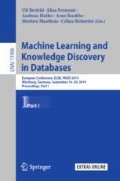Abstract
Reliably detecting anomalies in a given set of images is a task of high practical relevance for visual quality inspection, surveillance, or medical image analysis. Autoencoder neural networks learn to reconstruct normal images, and hence can classify those images as anomalies, where the reconstruction error exceeds some threshold. Here we analyze a fundamental problem of this approach when the training set is contaminated with a small fraction of outliers. We find that continued training of autoencoders inevitably reduces the reconstruction error of outliers, and hence degrades the anomaly detection performance. In order to counteract this effect, an adversarial autoencoder architecture is adapted, which imposes a prior distribution on the latent representation, typically placing anomalies into low likelihood-regions. Utilizing the likelihood model, potential anomalies can be identified and rejected already during training, which results in an anomaly detector that is significantly more robust to the presence of outliers during training.
Access this chapter
Tax calculation will be finalised at checkout
Purchases are for personal use only
References
Alain, G., Bengio, Y.: What regularized auto-encoders learn from the data-generating distribution. J. Mach. Learn. Res. 15(1), 3563–3593 (2014)
Bengio, Y., Yao, L., Alain, G., Vincent, P.: Generalized denoising auto-encoders as generative models. Adv. Neural Inf. Process. Syst. 1, 899–907 (2013)
Brodersen, K.H., Ong, C.S., Stephan, K.E., Buhmann, J.M.: The balanced accuracy and its posterior distribution. In: International Conference on Pattern Recognition, pp. 3121–3124. IEEE (2010)
Chan, P.P., Lin, Z., Hu, X., Tsang, E.C., Yeung, D.S.: Sensitivity based robust learning for stacked autoencoder against evasion attack. Neurocomputing 267, 572–580 (2017)
Chandola, V., Banerjee, A., Kumar, V.: Anomaly detection: a survey. ACM Comput. Surv. (CSUR) 41(3), 15 (2009)
Erfani, S.M., Rajasegarar, S., Karunasekera, S., Leckie, C.: High-dimensional and large-scale anomaly detection using a linear one-class svm with deep learning. Pattern Recogn. 58, 121–134 (2016)
Feinman, R., Curtin, R.R., Shintre, S., Gardner, A.B.: Detecting adversarial samples from artifacts. arXiv preprint arXiv:1703.00410 (2017)
Goodfellow, I., et al.: Generative adversarial nets. Adv. Neural Inf. Process. Syst. 2, 2672–2680 (2014)
Hawkins, D.M.: Identification of Outliers, vol. 11. Springer, Dordrecht (1980)
Hinton, G.E., Salakhutdinov, R.R.: Reducing the dimensionality of data with neural networks. Science 313(5786), 504–507 (2006)
Japkowicz, N., Myers, C., Gluck, M., et al.: A novelty detection approach to classification. In: Proceedings of the International Joint Conference on Artificial Intelligence, vol. 1, pp. 518–523 (1995)
Kingma, D.P., Ba, J.: Adam: a method for stochastic optimization. In: Proceedings of the International Conference on Learning Representations (2015). http://arxiv.org/abs/1412.6980
Kingma, D.P., Welling, M.: Auto-encoding variational bayes. In: Proceedings of the International Conference on Learning Representations (2014)
LeCun, Y., Bottou, L., Bengio, Y., Haffner, P.: Gradient-based learning applied to document recognition. Proc. IEEE 86(11), 2278–2324 (1998)
Leveau, V., Joly, A.: Adversarial autoencoders for novelty detection. Technical report, Inria - Sophia Antipolis (2017). https://hal.inria.fr/hal-01636617
Makhzani, A., Shlens, J., Jaitly, N., Goodfellow, I., Frey, B.: Adversarial autoencoders. arXiv preprint arXiv:1511.05644 (2015)
Ruff, L., et al.: Deep one-class classification. In: Proceedings of the International Conference on Machine Learning, pp. 4390–4399 (2018)
Schölkopf, B., Platt, J.C., Shawe-Taylor, J., Smola, A.J., Williamson, R.C.: Estimating the support of a high-dimensional distribution. Neural Comput. 13(7), 1443–1471 (2001)
Shah, M.P., Merchant, S., Awate, S.P.: Abnormality detection using deep neural networks with robust quasi-norm autoencoding and semi-supervised learning. In: Proceedings of the 15th International Symposium on Biomedical Imaging, pp. 568–572. IEEE (2018)
Vincent, P., Larochelle, H., Bengio, Y., Manzagol, P.: Extracting and composing robust features with denoising autoencoders. In: Proceedings of the International Conference on Machine Learning, pp. 1096–1103. ACM (2008)
Vincent, P., Larochelle, H., Lajoie, I., Bengio, Y., Manzagol, P.: Stacked denoising autoencoders: learning useful representations in a deep network with a local denoising criterion. J. Mach. Learn. Res. 11, 3371–3408 (2010)
Williams, G., Baxter, R., He, H., Hawkins, S., Gu, L.: A comparative study of RNN for outlier detection in data mining. In: Proceedings of the 2002 IEEE International Conference on Data Mining, pp. 709–712. IEEE (2002)
Xiao, H., Rasul, K., Vollgraf, R.: Fashion-MNIST: a novel image dataset for benchmarking machine learning algorithms. arXiv preprint arXiv:1708.07747 (2017)
Zhai, S., Cheng, Y., Lu, W., Zhang, Z.: Deep structured energy based models for anomaly detection. In: Proceedings of the International Conference on Machine Learning, pp. 1100–1109 (2016)
Zhou, C., Paffenroth, R.C.: Anomaly detection with robust deep autoencoders. In: Proceedings of the 23rd ACM SIGKDD International Conference on Knowledge Discovery and Data Mining, pp. 665–674. ACM (2017)
Acknowledgments
This work has been partially supported by the German Federal Ministry of Education and Research (BMBF) under Grant No. 01IS18036A. The authors of this work take full responsibilities for its content.
Author information
Authors and Affiliations
Corresponding author
Editor information
Editors and Affiliations
Rights and permissions
Copyright information
© 2020 Springer Nature Switzerland AG
About this paper
Cite this paper
Beggel, L., Pfeiffer, M., Bischl, B. (2020). Robust Anomaly Detection in Images Using Adversarial Autoencoders. In: Brefeld, U., Fromont, E., Hotho, A., Knobbe, A., Maathuis, M., Robardet, C. (eds) Machine Learning and Knowledge Discovery in Databases. ECML PKDD 2019. Lecture Notes in Computer Science(), vol 11906. Springer, Cham. https://doi.org/10.1007/978-3-030-46150-8_13
Download citation
DOI: https://doi.org/10.1007/978-3-030-46150-8_13
Published:
Publisher Name: Springer, Cham
Print ISBN: 978-3-030-46149-2
Online ISBN: 978-3-030-46150-8
eBook Packages: Computer ScienceComputer Science (R0)


